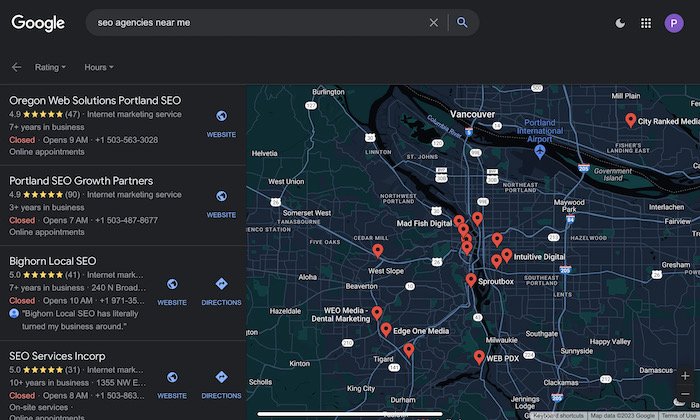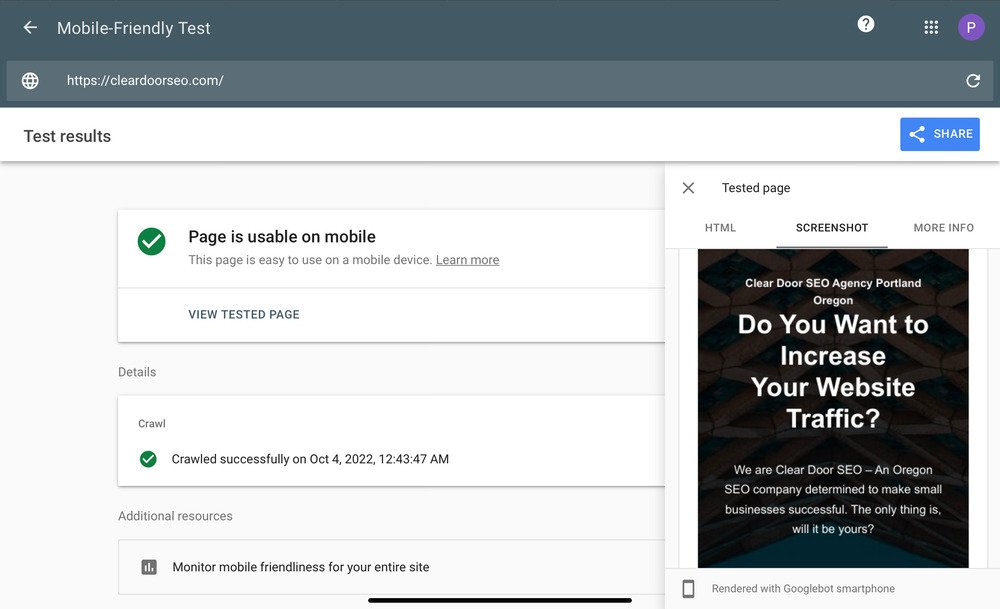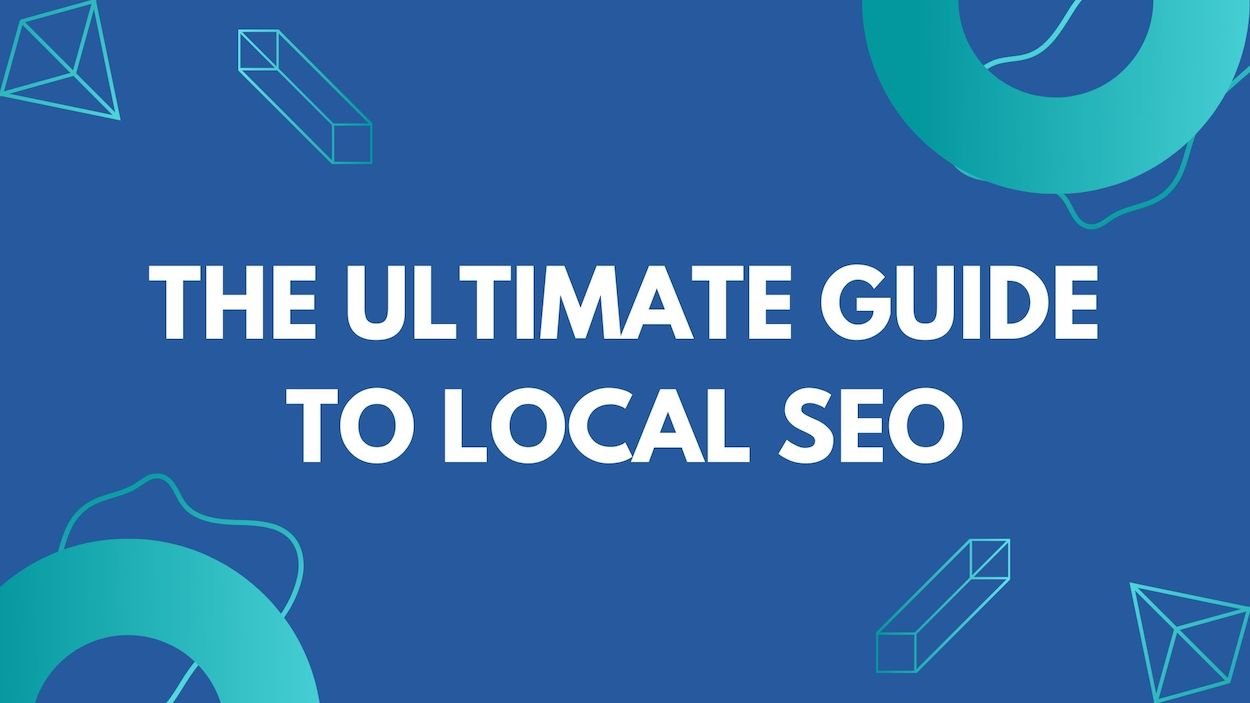Did you know that 88% of customers who do local searches on their mobile device visit the store or call within a day? In fact, 46% of all Google searches are looking for local information, which means if your business is not optimized for local search results, you are probably missing out on potential customers who shop in your local area. Long story short, local SEO plays a crucial role in your business and helps to stay relevant in the market. You know local search and Google my business is important for success. But do you actually know ‘What is Local SEO?’
To help you understand exactly what goes into local search optimization and your local ranking, we have a comprehensive guide on how to optimize for your small business’s local SEO. In this blog post, we will focus on getting your small business into local results by focusing on local intent. All with the main goal to drive highly-motivated and relevant organic traffic to your business.
For this article, we are focusing on local search tactics only, so, without further ado, let us jump into: What is local SEO?
Table of Contents
What is local SEO?
Local SEO is the strategy used to increase a website’s visibility and performance for local searches on Google and other search engines. It is designed to help businesses be found for commercial-based queriers. Businesses can enhance the organic traffic from customers in nearby regions by adhering to the best practices of local SEO
While SEO as a whole focuses on optimizing your website and increasing its visibility for search results everywhere. Local SEO marketing focuses on getting your business in front of a potential customer locally.
What do I need for local SEO?
Local SEO requires a strategy. One that is slightly different than traditional SEO methods and practices. Whereas, local search engine optimization will use tools like local directories, local citations, reviews, and getting featured on local listings.
It is also important to get a Google Business Profile so your company can be featured in the local pack, as well as in the map pack when people search for your services or products in your area.
To gather information for local searches, search engines depend on indicators such as local content, social profile pages, customer reviews, and citations. So make sure you have setup your social profiles, and have got listed on local directories! With these signals pointing back to your website, it makes it easier for you to rank on Google’s local listing.
Lets now dive into why local SEO is important!
Why is local SEO important?
Local SEO increases the visibility of your business in local commercially driven searches. It helps potential customers find your services and products by featuring your company in the local pack and local map pack on Google. Ultimately, it helps increase in-store foot traffic and sales.
By using a local keyword, you will be able to get more people finding and visiting your store, or requesting your service in your area. Doing this local SEO work is important for your company for the reasons listed above, and, because no one else in your industry is doing it! That’s right none of the other small businesses in your area are doing local SEO! This means there is huge potential for your business to step in and take the number one spot on Google’s local results.
Who needs local SEO marketing?
Below are a few examples of who should consider developing a local SEO marketing strategy:
- Local businesses: If you are a bricks-and-mortar location and you want to drive more customers to your physical location
- Multi-location brands: To help past customers find your brand that they trust in a new location
- Service-area businesses: For any business performing local service-related activities like Dentists, doctors, plumbers, contractors, and so on.
To help your business be found and succeed online, have a look at the local SEO marketing tips below.
Guide to Local SEO: 12 Tips and Strategies
Here are 12 local SEO tips to help you optimize your business and drive more traffic through local searches.
- Optimize for Google Business Profile
- Be active on social media platforms
- NAP (Name, Address and Phone number) is consistent online
- Optimize your online citations and directories
- Perform a local SEO audit
- Improve your internal linking structure
- Perform on-page optimization
- Add location pages to your site
- Focus on local content
- Ensure your website is mobile-friendly
- Get inbound links with relevance and authority
- Participate in your local community
1. Optimize for Google Business Profile
Formerly called Google My Business or GMB, Google Business Profile is a critical part of local search. Google feels confident when sharing content that it can verify and support and therefore, Google Business Profile is their tool to help your business meet the basic standards of Google.
To ensure that your business is optimized for Google Business Profile, you’ll need to:
- Create and verify a Google Business Profile page
- Use Google posts in your account
- Encourage your customers to leave reviews online
- Respond politely, authentically and professionally to reviews, specifying your location or product/ service.
If Google can verify your business as credible and authentic, then the search engine could potentially reward your business with a sidebar space in Google local search.
However, it is not recommended to do this just for SEO purposes. Think of it this way, by keeping your contact information, operating hours up-to-date and having reviews helps to improve a customer’s experience and makes it easier to find you. Finding updated information has been important more than ever especially after the Covid disruption has increased changes in business operation and shopping behavior of consumers.
2. Be active on social media platforms
We cannot deny the fact that Google considers shared content on social media more important than ever. Because more shares means more credible, relevant and authoritative content. Therefore, engage on various social media platforms like Facebook, Instagram, YouTube. Create relevant content that speaks to people and focus on specifying products and services available in your area.
Additionally, you can also promote your Google Business Profile by sharing it on social media platforms and further align with your local searches.
3. Name, address and phone number (NAP) is consistent online
NAP is essential and helps to find your business easily. Additionally,, it also makes it easier for search engines to find your business online. To do this you need to:
- Setup your NAP with your area code
- It should be included as a crawlable HTML text on your website
It is important to note that only including NAP within an image will not be crawled by search engines. Therefore, the most common location to insert the NAP is in the header or footer of the site.
4. Optimize your online citations and directories
For companies located in the US, utilize these four map data aggregators which provides a significant amount of the map data for Apple, Yelp, Bing, Google, and many more.
Consistency is key in SEO and it is essential to verify your citations are consistent and complete across these four data aggregators or any other directories to come across.
Small discrepancies like abbreviations, misspellings, lack of area code or wrong phone number can be problematic. If Google cannot determine which information about your business it correct, then it might just nor show your business in search results.
It is also worth noting that to remove any additional copy or duplicate listings you find in the search results.
5. Perform a local SEO audit
You may have done everything to optimize your business and might want to slow down with your SEO process. However, we’ve mentioned in several instances that SEO is a continuous process and slowing down or stopping all SEO efforts will hamper your businesses traffic and visibility. Therefore, instead of doing things slow or completely stopping these efforts, you simply run a site audit to see where your website is in the race and fill in the gaps to achieve your goals.
A local SEO audit includes the following:
- Google Business Profile Audit: How does your business appear in the Business Profile in the search results? Is the information correct?
- Google Search Console Audit: Is your website crawlable? Does it have any errors that hinder indexing?
- On-Page SEO Audit: Has your site been optimized for all the essential elements of on-page SEO that help ranking?
- Citation Audit: Are the citations accurate in the top for business directories?
- Competitor Analysis: Is your site able to match up with the competitors? Are there any gaps that need to be filled? How close is your match in terms of content, design, backlinks, and positioning? Conduct an SEO competitor analysis to understand the current gaps with your website’s performance.
6. Improve internal linking structure
External links that point to your website are ideal, but adjusting internal linking structure will also significantly improve your SEO rankings. Internal linking matters because:
- It supports easy navigation within the site
- Improves website hierarchy and assists with information architecture
- Distributes page authority and ranking power among pages
7. Perform on-page optimization
Whenever you publish a new content, it is a new indexed page for your website, a new page to target a specific geographic search phrase, and a new opportunity to get found in the search results.
Every time you write a new piece of content, you need to perform on-page optimization. This includes ensuring that the content uses high-volume keywords in the URL, title, header tags, meta descriptions, and body. For creating geographically targeted content, consider highlighting customer success stories and case studies.
8. Adding location pages

If you have more than one physical store, then it is recommended to create location pages. Location pages will provide readers with your NAP, operating hours, store descriptions, parking information, promotions, and reviews from satisfied customers.
It is also essential to avoid duplicating content across different location pages. For instance, a single location business can create a locally descriptive About Us page. It is also helpful to your site if you add a Google Map to your website on all your location pages.
9. Focus on local content
When you’re focused on targeting the local market, then it makes more sense to create local content for your business. Also, as Google gets smarter day by day, content creators can write content for readers and not search engines. This is your opportunity to create local content to attract new local customers.
You can take the advantage by promoting your local industry gatherings,news, and other educational content on your blog. You don’t need to limit your blog to your product and services and can create content on anything related to your industry. Think of the top of the funnel content that goes beyond what your business offers.
For example, if you are a new local coffee bean company and you are trying to attract restaurants and cafes that are new to the area, you can create helpful resources to get these businesses acquainted with your city. You can provide a map of local service providers that could provide value for your person and contain highly relevant on-page local signals.
10. Ensure your website is mobile friendly
As Google shows that 61% of searches are performed on smartphones, local search and mobile search work together.
One of the most common ways that visitors will use your site on their smartphones is to check reviews, find directions to your business location and search for contact information. As a matter of fact, “near me” searches on mobile have increased 250% since 2017.
Therefore, it is crucial to ensure that your site is mobile friendly for your prospects. You can check if your website is mobile friendly with Google’s Mobile-Friendly Test tool.

11. Relevant and authoritative inbound links
Inbound links are powerful opportunities to skyrocket your local SEO. Every inbound link you get informs Google that you’re a legit company and helps to increase your domain authority. Few tips to get inbound links:
- Partnerships or sponsorships
- Guest blogging
Consider sponsoring a meet-up or webinar, hosting a community event, promoting local products, and building relationships with prominent people or influencers. Additionally, you need to feel less obligated and learn to feel free and comfortable while reaching out to different patterns to see if they can feature your business on their partner directory.
Also, guest blogging can help attract a lot of links. Talk about other people in your industry and act as a local resource provider for the community. If you’re active in the community, then the buzz around you will flourish in the form of inbound links, social media growth and media coverage.
12. Participate in your local community
The more you participate in the local community, the more digital PR you will get. Partnering with local nonprofits on a cause or campaign, organizing different charity events, sponsoring an online event are all different ways to earn brand awareness and inbound links.
Key Takeaways: Ultimate guide to local seo
Local SEO is an essential part of any SEO effort for local businesses. Whether you have an online store or storefront, with these 12 local SEO basics your audience will be able to find you much easier. Local SEO focuses on improving your visibility and rankings in local search engines. By optimizing your online presence to drive local prospects to your store will also help you to increase your sales and revenue.
If you need help creating a better local SEO campaign, you may want to consider contacting a digital marketing agency that specializes in local SEO.
Clear Door SEO is an Oregon SEO company in Portland that offers a wide variety of SEO services. We specialize in local SEO, as well as all SEO services to drive more traffic and increase your revenue. If you would like to see how your current local SEO performance is, use our free website analysis!
